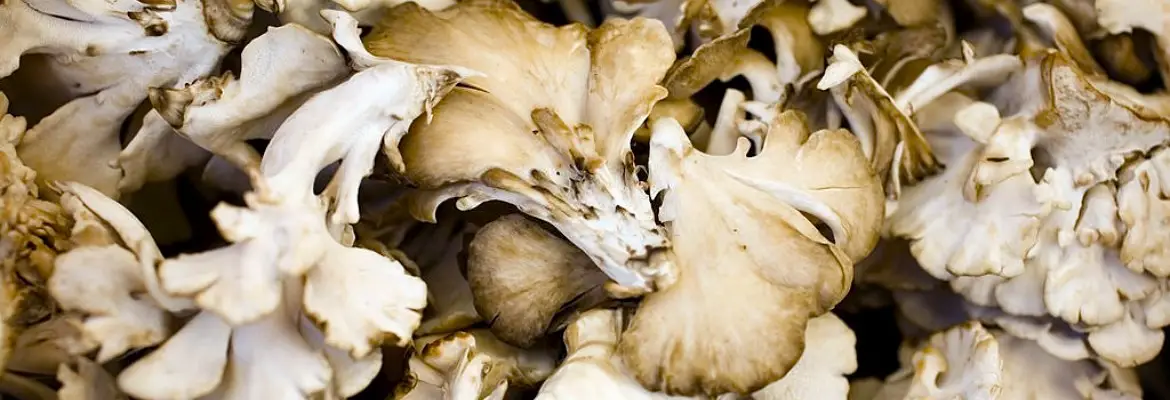Among the most nutritionally dense polypores are maitake mushrooms. These mushrooms are not only being used in culinary but also for medicinal purposes.
Maitake mushrooms are generally short-lived when fresh. Dehydrated maitake mushrooms, however, can be stored for extended periods of time when air-dried, allowing chefs to use the umami-rich fungi year-round.
There are layers of tightly packed, smooth caps on the surface of the fruiting body of maitake mushrooms. In this variety, there are no gills. Instead, the underside of the caps are pocked with tiny pores.

It is common to break dried maitake mushrooms into smaller pieces after they are dehydrated naturally, resulting in delicate clusters of slender, flat, and shrunk caps. Their colors range from brown to tan to ivory to cream and, when dried, their texture is semi-rough, brittle, and crisp.
The dried Maitake mushroom develops a chewy, slightly firm, meat-like texture when it is cooked. Smoky and earthy, with hints of spices like clove, ginger, and cinnamon, this taste is umami-full.
As with fresh maitake mushrooms, dried maitake mushrooms can be used to enhance culinary dishes with savory, smokey, and earthy flavors. Dried maitake mushrooms are also used as an immunity booster in Eastern medicines and teas.
Potassium, fiber, and copper are all abundant in maitake mushrooms. Furthermore, maitake mushrooms contain vitamin D, niacin, antioxidants, and beta-glucans. To strengthen the immune system and reduce blood pressure, Maitake mushrooms were commonly steeped into tea, taken as capsules, or made into a tonic in traditional medicine of Japan.
Scientific name of Maitake Mushroom
Grifola Frondosa
Other names of Maitake Mushroom
- Champignon Dansant
- Grifola
- Monkey’s Bench
- Shelf Fungi
- Dancing Mushroom
- Hen of the woods
Calories by source in Maitake Mushroom
- Calories by carbohydrate in Maitake Mushroom = 78%
- Calories by fat in Maitake Mushroom = 5%
- Calories by protein in Maitake Mushroom = 16%
Fats and Fatty Acid profile of Maitake Mushroom
- Polyunsaturated fat (PUFA) in Maitake Mushroom = 60%
- Saturated fat (SFA) in Maitake Mushroom = 20%
- Monounsaturated fat (MUFA) in Maitake Mushroom = 20%
Nutrition facts of Maitake Mushroom
*Serving size = 100 grams = 3.55 Ounces = 1/2 cup
*DV= % Daily Value (%DV indicates how much nutrients contribute to a person’s daily diet from a serving of a food. DV assists you in determining whether or not a serving of food is high or low in a particular nutrient.)
| Nutrient | Amount | Unit | DV |
|---|---|---|---|
| Calories | 31 | KCAL | |
| Fat | 0.19 | GRAM | 0% |
| Protein | 1.94 | GRAM | 4% |
| Carbohydrate | 6.97 | GRAM | 3% |
Detailed vitamin profile of Maitake Mushroom, vitamin A, vitamin B12, vitamin B6, vitamin C, vitamin D, Folate, Niacin, Thiamin, and Riboflavin is shown in the chart.
Detailed mineral profile of Maitake Mushroom, Sodium(Na), Calcium(Ca), Copper(Cu), Iron(Fe), Magnesium(Mg), Selenium(Se), Phosphorus(P), Potassium(K) and Zinc(Zn) is shown the chart.
Availability of maitake mushroom
- Dried maitake mushroom is available round the year
Complete nutrition facts of Maitake Mushroom
Click on the link HERE to download high quality, high resolution and print ready PDF version of the Maitake Mushroom nutrition chart/infographic.


